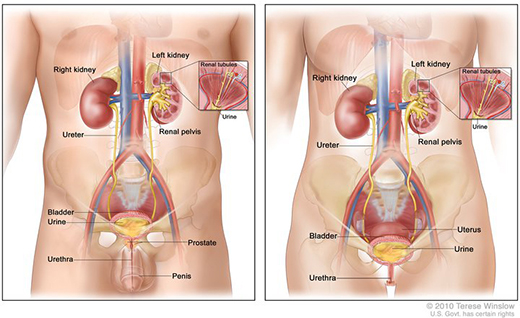What Color Is Old Blood In Bladder
What is hematuria?
Hematuria is the presence of claret in a person's urine. The two types of hematuria are
- gross hematuria—when a person can see the blood in his or her urine
- microscopic hematuria—when a person cannot see the blood in his or her urine, yet it is seen under a microscope

What is the urinary tract?
The urinary tract is the body'south drainage system for removing wastes and extra fluid. The urinary tract includes
- two kidneys
- two ureters
- the bladder
- the urethra
The kidneys are two bean-shaped organs, each about the size of a fist. They are located just beneath the rib cage, 1 on each side of the spine. Every day, the kidneys filter about 120 to 150 quarts of blood to produce about one to 2 quarts of urine, composed of wastes and extra fluid. Children produce less urine than adults. The urine flows from the kidneys to the float through tubes called ureters. The float stores urine until releasing it through urination. When the float empties, urine flows out of the body through a tube called the urethra at the lesser of the bladder.
What causes hematuria?
Reasons people may have blood in the urine include
- infection in the bladder, kidney, or prostate
- trauma
- vigorous exercise
- viral disease, such as hepatitis—a virus that causes liver illness and inflammation of the liver
- sex
- menstruation
- endometriosis—a trouble in women that occurs when the kind of tissue that usually lines the uterus grows somewhere else, such as the bladder
More than serious reasons people may have hematuria include
- bladder or kidney cancer
- inflammation of the kidney, urethra, bladder, or prostate—a walnut-shaped gland in men that surrounds the urethra and helps make semen
- blood-clotting disorders, such as hemophilia
- sickle cell disease—a genetic disorder in which a person'southward torso makes abnormally shaped reddish claret cells
- polycystic kidney disease—a genetic disorder in which many cysts grow on a person's kidneys
Who is more likely to develop hematuria?
People who are more likely to develop hematuria may
- have an enlarged prostate
- have urinary stones
- have certain medications, including blood thinners, aspirin and other pain relievers, and antibiotics
- practice strenuous exercise, such every bit long-altitude running
- accept a bacterial or viral infection, such equally streptococcus or hepatitis
- have a family history of kidney illness
- have a affliction or condition that affects one or more organs
What are the symptoms of hematuria?
People with gross hematuria have urine that is pink, red, or brownish. Even a small-scale amount of blood in the urine can cause urine to change color. In most cases, people with gross hematuria do not have other signs and symptoms. People with gross hematuria that includes claret clots in the urine may have bladder pain or pain in the back.
How is hematuria diagnosed?
A health care professional diagnoses hematuria or the cause of the hematuria with
- a medical history
- a physical exam
- urinalysis
- additional testing
Medical History
Taking a medical history may assist a health care professional person diagnose the cause of hematuria. He or she will ask the patient to provide a medical history, a review of symptoms, and a list of prescription and over-the-counter medications. The health care professional will likewise ask nearly current and by medical weather condition.
Physical Exam
During a physical examination, a wellness care professional most often taps on the abdomen and back, checking for hurting or tenderness in the bladder and kidney area. A health care professional may perform a digital rectal exam on a human to look for any prostate problems. A health care professional may perform a pelvic exam on a woman to look for the source of possible red claret cells in the urine.
Digital rectal exam. A digital rectal examination is a physical exam of a man'due south prostate and rectum. To perform the exam, the wellness intendance professional has the man curve over a table or lie on his side while holding his knees close to his chest. The wellness care professional slides a gloved, lubricated finger into the patient's rectum and feels the part of the prostate that lies in front of the rectum. The digital rectal exam is used to check for prostate inflammation, an enlarged prostate, or prostate cancer.
Pelvic examination. A pelvic exam is a visual and physical exam of a adult female's pelvic organs. The health care professional has the woman lie on her back on an examination table and place her feet on the corners of the table or in supports. The health care professional looks at the pelvic organs and slides a gloved, lubricated finger into the vagina to bank check for bug that may exist causing claret in the urine.
Urinalysis
The wellness care professional can test the urine in the function using a dipstick or can transport information technology out to a lab for assay. Sometimes urine tests using a dipstick can be positive fifty-fifty though the patient has no blood in the urine, which results in a "false-positive" test. The health intendance professional may look for red blood cells by examining the urine under a microscope before ordering further tests.
Prior to obtaining a urine sample, the health intendance professional may ask a woman when she last menstruated. Sometimes blood from a adult female's menstrual period can go into her urine sample and can result in a simulated-positive test for hematuria. The exam should be repeated after the adult female stops menstruating.

Additional Testing
Sometimes, a health care professional will test the patient's urine once again. If the urine samples detect too many red claret cells, a health care professional may club additional tests:
- Blood test. A blood test involves cartoon claret at a health care professional's part or a commercial facility and sending the sample to a lab for analysis. A claret test tin can find high levels of creatinine, a waste production of normal musculus breakup, which may point kidney affliction. Other claret tests may detect signs of autoimmune diseases, such every bit lupus, or other diseases, such as prostate cancer, which can cause hematuria.
- Computed tomography (CT) scan. CT scans use a combination of ten-rays and computer engineering science to create images of the urinary tract, especially the kidneys. A wellness intendance professional may give the patient a solution to potable and an injection of dissimilarity medium. CT scans crave the patient to lie on a table that slides into a tunnel-shaped device that takes the x-rays. An x-ray technician performs the procedure in an outpatient heart or a hospital, and a radiologist interprets the images. The patient does non need anesthesia. CT scans tin assistance a dr. diagnose stones in the urinary tract, obstructions, infections, cysts, tumors, and traumatic injuries.
- Cystoscopy. Cystoscopy is a procedure that a urologist—a doctor who specializes in urinary problems—performs to run across inside the patient's float and urethra using a cystoscope, a tubelike musical instrument. The wellness care professional performs cystoscopy in his or her function, in an outpatient centre, or in a hospital. The patient may need pain medication. A cystoscopy can detect cancer in a patient'due south bladder.
- Kidney biopsy. Kidney biopsy is a procedure that involves taking a pocket-sized piece of tissue from the kidney. A health care professional person performs the biopsy in an outpatient heart or a infirmary. The health care professional will requite the patient light sedation and local coldhearted. In some cases, the patient will require general anesthesia. A pathologist—a doctor who specializes in diagnosing diseases—examines the tissue in a lab. The biopsy can help diagnose if the hematuria is due to kidney disease.
- Magnetic resonance imaging (MRI). MRI is a test that takes pictures of the patient's internal organs and soft tissues without using x-rays. A especially trained technician performs the procedure in an outpatient centre or a hospital, and a radiologist interprets the images. The patient does not need anesthesia, although patients with a fearfulness of confined spaces may receive light sedation. An MRI may include the injection of contrast medium. With most MRI machines, the patient will prevarication on a tabular array that slides into a tunnel-shaped device that may be open-ended or closed at one end. Some machines allow the patient to lie in a more open up space. During an MRI, the patient should remain perfectly withal while the technician takes the images. During the procedure, the patient will hear loud mechanical knocking and bustling noises coming from the machine. An MRI can assist diagnose problems in individual internal organs, such every bit the bladder or kidney.
More data is provided in the NIDDK health topic, Imaging of the Urinary Tract.
How is hematuria treated?
Wellness intendance professionals care for hematuria by treating its underlying cause. If no serious condition is causing a patient'south hematuria, he or she typically does not need treatment.
Eating, Diet, and Nutrition
Researchers have not institute that eating, nutrition, and diet play a role in causing or preventing hematuria.
Points to Remember
- Hematuria is the presence of claret in a person's urine. Gross hematuria is when a person tin see the claret in his or her urine, and microscopic hematuria is when a person cannot see the blood in his or her urine, all the same a wellness intendance professional tin can run into it under a microscope.
- The causes of hematuria include vigorous exercise and sexual activity, amidst others.
- More serious causes of hematuria include kidney or bladder cancer; inflammation of the kidney, urethra, bladder, or prostate; and polycystic kidney disease, among other causes.
- People who are more likely to develop hematuria may have a family history of kidney affliction, have an enlarged prostate, or take bladder or kidney stones, among other reasons.
- People with gross hematuria have urine that is pink, red, or brown.
- Most people with microscopic hematuria do not have any symptoms.
- Taking a medical history may help a health care professional diagnose the crusade of hematuria.
- Health care professionals diagnose hematuria with a urine examination called urinalysis.
- If two of iii urine samples notice also many cerise claret cells, a health care professional may order one or more boosted tests.
- Wellness care professionals treat hematuria by treating its underlying cause.
- Researchers accept non found that eating, diet, and nutrition play a role in causing or preventing hematuria.
Clinical Trials
The National Institute of Diabetes and Digestive and Kidney Diseases (NIDDK) and other components of the National Institutes of Health (NIH) conduct and support research into many diseases and conditions.
What are clinical trials, and are they correct for you?
Clinical trials are part of clinical research and at the eye of all medical advances. Clinical trials expect at new ways to prevent, detect, or treat affliction. Researchers as well use clinical trials to look at other aspects of care, such equally improving the quality of life for people with chronic illnesses. Find out if clinical trials are right for you.
What clinical trials are open?
Clinical trials that are currently open up and are recruiting can be viewed at www.ClinicalTrials.gov.
Source: https://www.niddk.nih.gov/health-information/urologic-diseases/hematuria-blood-urine
Posted by: rineharttring1983.blogspot.com


0 Response to "What Color Is Old Blood In Bladder"
Post a Comment